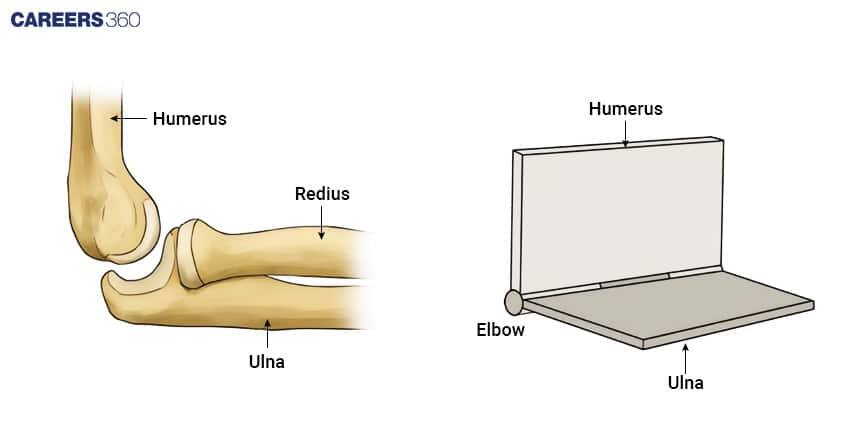Hinge Joint: Definition, Types, Examples, FAQs, Movement
It is a hinge joint that functions as the synovial joint allowing movement in only one direction, much like the swinging of a door. A hinge joint exists in parts of the human body such as the elbow, knee, and fingers to allow the bending and straightening action. Understanding what a hinge joint is can be made easy if one studies a diagram or picture of a hinge joint, which explains the anatomy and function of a hinge joint in detail. This is the topic of the Locomotion and Movement chapter of Biology.
NEET 2025: Mock Test Series | Syllabus | High Scoring Topics | PYQs
NEET Important PYQ's Subject wise: Physics | Chemistry | Biology
New: Meet Careers360 B.Tech/NEET Experts in your City | Book your Seat now
- Definition of Hinge Joint
- Structure of Hinge Joints
- Movements of Hinge Joints:
- Types of Hinge Joints:
- Implications of Hinge Joints
- Common Disorders and Injuries:

Definition of Hinge Joint
The Hinge Joint holds paramount importance in the human skeleton. It enables a special kind of movement used in our everyday routines and activities. Instead of ball and socket joint movement, which allows movement in multiple directions, the hinge joint moves on a single plane or two-directional movement backwards and forward.
Also Read:
Structure of Hinge Joints

These joints feature:
Articular Surfaces: A convex surface of one bone fitting into the concave surface of another.
Articular Capsule: Envelops the joint and includes synovial fluid to lubricate.
Ligaments: Join bones together and prevent too much movement of the joint.
Movements of Hinge Joints:
Hinge joints allow motion in the following manner:
Flexion: Decrease in the angle between the bones
Extension: Increase in the angle between the bones
This kind of movement is involved in vital activities like walking, holding, and bending limbs.
Types of Hinge Joints:
The examples are
Elbow Joint: Occurs between the humerus, radius, and ulna.
Knee Joint: The articulation between the femur, tibia, and patella.
Ankle Joint: The joint between the tibia, fibula, and talus.

Each type allows for different kinds of movements, as can be understood from their anatomic position and the functions associated with them.


Implications of Hinge Joints
The synovial hinge is one kind of synovial joint which is mainly in the motion direction. Here, it acts just like the swinging action of a door's hinge. The examples with descriptions of the hinge joint of the human body with some of their distinguishing characteristics are as follows:
The Elbow: The elbow, a classic hinge joint example, connects the humerus (upper arm) to the radius and ulna (lower arm bones) at the humeroulnar joint. This joint permits flexion and extension, critical for arm movement.
The Jaw: The jaw, though not a pure hinge joint, functions like one, enabling the opening and closing of the mouth while also allowing side-to-side movement.
The Hand: The interphalangeal joints in the fingers are the most important hinge joints. The proximal and distal interphalangeal joints enable flexion and extension movements, making the hand important for daily functions.
The Foot: The interphalangeal joints of the feet function similarly to those of the hands, which allow flexion and extension movements. Although the toes have a different anatomy than the fingers, they are similar in movement.
The Knee: The biggest hinge joint, the knee links the thigh to the lower leg. It permits flexion, extension, and some side-to-side movement, which makes it unique among other hinge joints.
The Ankle: Often referred to as the talocrural joint, the ankle is a complex hinge joint that consists of the talocrural, subtalar, and tibiofibular joints. It enables the movement of the foot, such as side-to-side motion.
Common Disorders and Injuries:
The common disorders include:-
Osteoarthritis: Degeneration of cartilage leading to joint pain and stiffness.
Sprains and Strains: Injuries to ligaments and tendons surrounding the hinge joints.
Dislocations: Occasional displacement caused due to trauma or high stress.
Also Read:
Frequently Asked Questions (FAQs)
Hinged joints provide movement in one plane of motion by the action of flexion—the angle becomes smaller and with extension— the angle becomes larger.
No, the shoulder is a ball and socket type joint which can make wide degrees of movement in different directions.
Hinge joints are constructed in the body to only allow movement in one plane, hence the advantage of stability and efficiency in movement.
Also Read
30 Nov'24 06:17 PM
28 Nov'24 05:27 PM
28 Nov'24 04:14 PM
28 Nov'24 03:07 PM
28 Nov'24 03:06 PM
28 Nov'24 01:21 PM
28 Nov'24 12:16 PM

